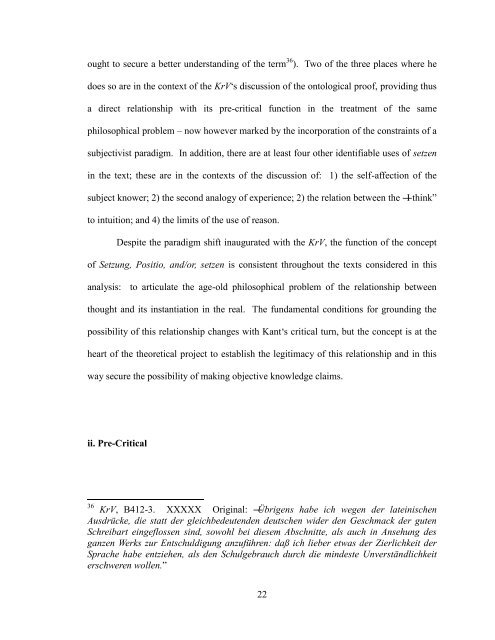The Doctrine of Self-positing and Receptivity in Kant's Late ...
The Doctrine of Self-positing and Receptivity in Kant's Late ...
The Doctrine of Self-positing and Receptivity in Kant's Late ...
Create successful ePaper yourself
Turn your PDF publications into a flip-book with our unique Google optimized e-Paper software.
ought to secure a better underst<strong>and</strong><strong>in</strong>g <strong>of</strong> the term 36 ). Two <strong>of</strong> the three places where he<br />
does so are <strong>in</strong> the context <strong>of</strong> the KrV‘s discussion <strong>of</strong> the ontological pro<strong>of</strong>, provid<strong>in</strong>g thus<br />
a direct relationship with its pre-critical function <strong>in</strong> the treatment <strong>of</strong> the same<br />
philosophical problem – now however marked by the <strong>in</strong>corporation <strong>of</strong> the constra<strong>in</strong>ts <strong>of</strong> a<br />
subjectivist paradigm. In addition, there are at least four other identifiable uses <strong>of</strong> setzen<br />
<strong>in</strong> the text; these are <strong>in</strong> the contexts <strong>of</strong> the discussion <strong>of</strong>: 1) the self-affection <strong>of</strong> the<br />
subject knower; 2) the second analogy <strong>of</strong> experience; 2) the relation between the ―I th<strong>in</strong>k‖<br />
to <strong>in</strong>tuition; <strong>and</strong> 4) the limits <strong>of</strong> the use <strong>of</strong> reason.<br />
Despite the paradigm shift <strong>in</strong>augurated with the KrV, the function <strong>of</strong> the concept<br />
<strong>of</strong> Setzung, Positio, <strong>and</strong>/or, setzen is consistent throughout the texts considered <strong>in</strong> this<br />
analysis: to articulate the age-old philosophical problem <strong>of</strong> the relationship between<br />
thought <strong>and</strong> its <strong>in</strong>stantiation <strong>in</strong> the real. <strong>The</strong> fundamental conditions for ground<strong>in</strong>g the<br />
possibility <strong>of</strong> this relationship changes with Kant‘s critical turn, but the concept is at the<br />
heart <strong>of</strong> the theoretical project to establish the legitimacy <strong>of</strong> this relationship <strong>and</strong> <strong>in</strong> this<br />
way secure the possibility <strong>of</strong> mak<strong>in</strong>g objective knowledge claims.<br />
ii. Pre-Critical<br />
36 KrV, B412-3. XXXXX Orig<strong>in</strong>al: ―Übrigens habe ich wegen der late<strong>in</strong>ischen<br />
Ausdrücke, die statt der gleichbedeutenden deutschen wider den Geschmack der guten<br />
Schreibart e<strong>in</strong>geflossen s<strong>in</strong>d, sowohl bei diesem Abschnitte, als auch <strong>in</strong> Ansehung des<br />
ganzen Werks zur Entschuldigung anzuführen: daß ich lieber etwas der Zierlichkeit der<br />
Sprache habe entziehen, als den Schulgebrauch durch die m<strong>in</strong>deste Unverständlichkeit<br />
erschweren wollen.‖<br />
22


